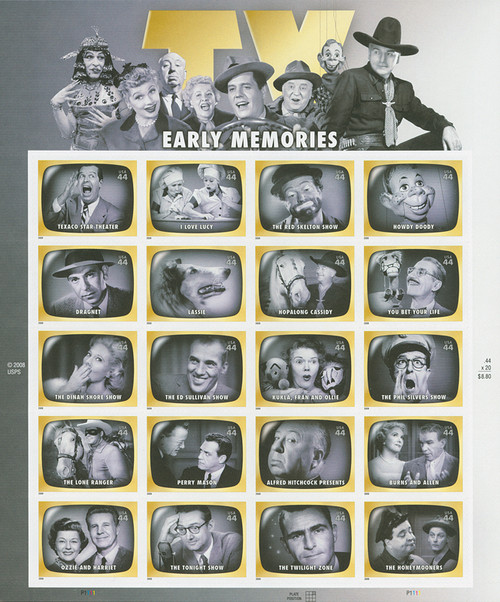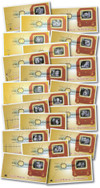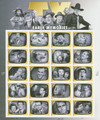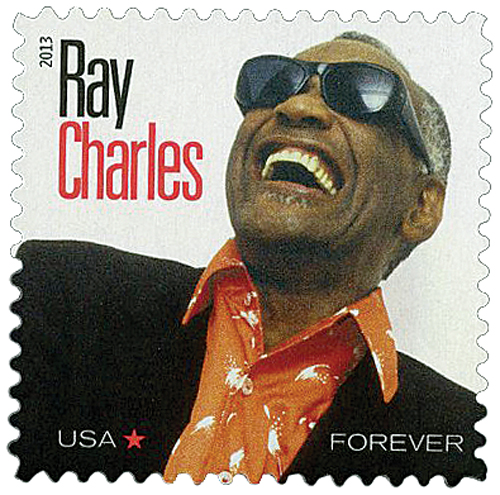
# 4414 - 2009 44c Early TV Memories
Early Television Memories
Issue Date: August 11, 2009
City: North Hollywood, CA
Texaco Star Theater: By 1948, television was just starting to take off. But it needed a face, a superstar, and it found one on radio. Texaco Star Theater transferred its successful radio show to television, and brought along “Uncle Miltie.” The show was a smash hit, with as many as four out of every five television sets tuned in. This variety show had a little bit of everything, including smiling representatives of the sponsor singing the theme song and performing good deeds throughout the show.
I Love Lucy: In the 1950s, a red-headed fashion model found fame as a frazzled housewife, and the whole world fell in love with Lucy. She played a housewife frustrated with her limited lifestyle, compared to her show-biz husband. Their misadventures were a smash hit – it was the top-rated show in the early 1950s, with the highest-rated episode being her trip to the hospital to give birth. The couple’s zany television personalities were the opposite of their savvy, real-life business instincts. As a result, this beloved classic still prospers in syndication more than a half century later.
The Red Skelton Show: Whether portraying an optimistic hobo or a country bumpkin, Red made audiences laugh for 20 years. The hats were the key – by putting on a different hat, he turned into characters that were funny, yet unaware of their own silliness. Nicknamed “America’s Clown Prince,” Red was a master of pantomime who was also famous for his comic clumsiness. For all his laughs, Red always ended his shows on a sincere note and bid the audience farewell by saying “Good night, and may God bless.”
Howdy Doody: Forty-eight freckles peppered the face of the puppet – one for each U.S. state at the time. Red-haired and plucky, he was the all-American boy with the ear-to-ear grin. He and the other puppets were treated as if they were real people, and that helped the young audience look at them the same way. Skits featured humans and puppets working together to solve problems. The show ended on its most famous note, when the clown who never spoke whispered a tearful farewell to the children viewers.
Dragnet: The idea seemed simple – that the daily drama faced by real police officers was as exciting as any that Hollywood scriptwriters could make up. But it had never been done before. The creators of the show worked hard for realism and the actors trained with Los Angeles police detectives. Episodes were based on actual police cases. The steps were the same as those taken by the police in solving the cases, and only the names of the people involved were changed. The result was a gripping drama in the early days of television that set the standard for future police shows.
Lassie: A dog is often called man’s best friend, and that was the case in this long-running series. From 1954-74, the show focused on the relationship of an intelligent collie and her human friends. Loyal and protective, this canine companion constantly helped the humans out of trouble. Little Timmy found himself in a never-ending series of predicaments. Episodes often ended with a cliffhanger, leaving viewers wondering how this canine lady would save the day. The collie became a symbol of faithfulness and perseverence. Ironically, this “female” was played by a male dog.
Hopalong Cassidy: In early television, heroes wore white and bad guys wore black – a simple, but effective imagery. Not so for Hopalong Cassidy. In the rough-and-tumble West, black-clad Cassidy was a model of virtue. He didn’t drink, smoke, or swear. He was always polite to the ladies, and used proper grammar. He had gleaming white hair even as a young man, and wore a black hat. “Hoppy” and his companions protected folks from cattle rustlers and outlaw gangs, providing a standard of decency in the untamed West that was also a model for his young, modern viewers.
You Bet Your Life: No matter how innocent the comment, one waggle of this game show host’s bushy brows could turn it into a blushing confession. Often the interaction between host and contestants was more interesting than the game itself. Each week a pair of contestants, usually including one celebrity, answered contest questions for cash prizes and matched wits with their host. The larger-than-life comic entertained early audiences for 11 years and helped set the standard for future game shows.
Dinah Shore: From 1951-63, Dinah hosted a live musical show with style and grace. She was as warm and easy as her singing voice and was famous for ending each show by blowing an enthusiastic kiss to the audience with an exaggerated “M-wah!” The biggest names in entertainment came to perform on this well-produced show. Using advanced production technology, groundbreaking effects such as flying performers wowed ‘50s audiences. With this showcase of talent, quality, and charm, Dinah found a place in America’s heart.
Ed Sullivan: As television sales began to skyrocket in 1948, America discovered a host of talented performers. Ed was the man to introduce them. A keen evaluator of talent, he had a knack for assessing and satisfying the nation’s interests. Performances by the Beatles and Elvis became legendary, and an appearance on the show was seen as a ticket to stardom. Overall, more than 10,000 entertainers appeared during the show’s 23-year run.
Kukla, Fran and Ollie: A simple set was the forum for an imaginative show. It was just a woman standing in front of a stage, talking with a group of puppets. But the show mixed gentle humor with keen wit, resulting in a children’s show as popular with adults as it was with children. As author James Thurber noted, from 1948-57, the show was “helping to save the sanity of the nation and to improve, if not even to invent, the quality of television.” Whether it was a puppet witch getting arrested by Interpol for flying too low over the United Nations building, or a dragon giving his niece a bath, the puppets appealed to audiences of all ages.
Phil Silvers: It’s hard to be a con man with a heart of gold. That was one theme of this early military comedy. Stationed on a Midwest army base with not enough to do, one Master Sergeant was the resident con artist who constantly cooked up get-rich-quick schemes or plans for promotion. But his main enemy was his own conscience, and often he ended up saving his friends from his own cons. The show lasted from 1955-1959 before being canceled while still popular, and its light-hearted view of the military inspired a host of similar shows.
The Lone Ranger: He was everything a hero ought to be – honest, brave, and righteous. He became a children’s role model – the noble lawman fighting crime and injustice in the Wild West. He was an ex-Texas Ranger whose brother and friends were slain by desperadoes. Armed with expensive silver bullets as a reminder that life (like silver) was precious, the hero and his partner preferred non-lethal means to defeat the bad guys. The duo would then ride away, leaving people wondering, “Who was that masked man?”
Perry Mason: Dramatic courtroom confessions were standard fare for the longest-running lawyer show on television. Debuting in 1957, the show was as much about detective work as it was about the law. The defense attorney was assisted by his junior partner and legal assistant to help his clients. Armed with a keen mind and cool, penetrating stare, this courtroom avenger always found out the truth. Last-minute evidence and exciting courtroom climaxes often led to the wrongly accused being spared and the guilty brought to justice. The show set the standard for other classic criminal dramas. It lasted for nine years and is still popular in syndication.
Alfred Hitchcock Presents: The “Master of Suspense” brought terror into American homes – and audiences loved it. For a director known for his horror films, Alfred also enjoyed sharing his playfully morbid sense of humor with an audience uncertain if it should laugh. Audiences accustomed to light-hearted variety shows and middle-class dramas were introduced to taut thrillers that featured some of the best-known actors of the day. Frequently, the villains appeared to succeed in their mischief. But Alfred always came back to explain how the villains had actually received the justice they deserved.
The George Burns and Gracie Allen Show: It took a lot of intelligence to appear so clueless, and Gracie did it well. George played the “straight man” and was the perfect complement to his scatter-brained wife. A married couple both on screen and off, these vaudeville veterans were the stars of the first show about show business families. George was famous for suddenly stepping outside of the story and chatting with the audience, while fans loved Gracie’s zany antics. She had a gift for making simple tasks seem complicated. The show ended when she retired in 1958, saying “good night” for the last time.
Ozzie and Harriet: The show was about a family of entertainers played by the real-life family members. This included the father, the mother, and their two sons. The youngest son played music on the show to impress a girlfriend, and it was very popular. He went on to have a successful pop music career. America watched the boys grow during the course of the series, and when they got married in real life, their wives joined the show. The focus on daily events created an image of the ideal American family.
The Tonight Show: A little entertainment, light chat, a skit or two – that was the idea behind this show that premiered in 1954. Starting out as a local New York City broadcast, it quickly went nationwide and has been going strong for more than half a century. It was light musical comedy to start – when Steve stepped over to the piano, the audience was treated to some light banter or musical improvisation. Later hosts influenced the show with their unique personalities. But some things have lasted through the years, such as the opening monologues and decades of entertaining audiences.
Twilight Zone: Early television did not allow social commentary on contemporary issues such as nuclear war or bigotry, but this unique show found a way around censors. These hot-button topics were explored by presenting the stories as science fiction, featuring things like space aliens, time travel, or alternate worlds. The narrator opened every episode with sly irony, inviting early audiences into a world where anything was possible, yet people were still bound by their nature.
The Honeymooners: The working class found its champion in this show about the ultimate underdog. Starring Ralph, a blustering bus driver, and his sensible wife, Alice, this classic dominated early television. Living in a small, mostly empty apartment, Ralph had dreams much bigger than his salary could grant him. With his upstairs neighbor Ed as his sidekick, Ralph cooked up schemes to make the big score, but things never worked out as he hoped. Audiences related to the day-to-day struggles of this working-class couple.
Birth Of Ed Sullivan
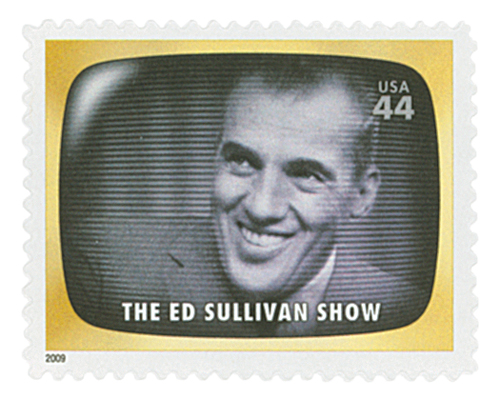
Legendary TV personality Ed Sullivan was born on September 28, 1901, in Harlem, New York City, New York.
Sullivan grew up in a musical household, with someone always singing or playing the piano. Sullivan was a gifted athlete, playing football, basketball, baseball, and track.
While in high school, Sullivan wrote sports news for The Port Chester Daily and was hired full-time after graduation. Over the next decade, he continued to work as a sports writer and editor for a series of different newspapers. Then in 1929, he was made the Broadway columnist for The Daily Mirror. During this time he would also do show business broadcasts on the radio. And in 1933, he wrote and starred in the film, Mr. Broadway.

Sullivan soon earned a reputation as a star-maker, while continuing to write, produce vaudeville shows, and organizing benefit concerts. He was also made the host of the Summer Silver Theater variety program in 1941.
In June 1948, Sullivan was hired to host a weekly Sunday night variety TV show called Toast of the Town (it would later be renamed The Ed Sullivan Show in 1967). Initially, Sullivan and his show received poor reviews, with some complaining he had no personality and was awkward. But Sullivan soon won over viewers as the “average guy” bringing them entertainment in their homes. Sullivan had an instinct about what people liked and managed to create an interesting balance for the show. An episode would usually include a vaudeville act, a comedian, a singer, a jukebox star, a theatre performer, an athlete, and a visit with Topo Gigio, the Italian mouse puppet.
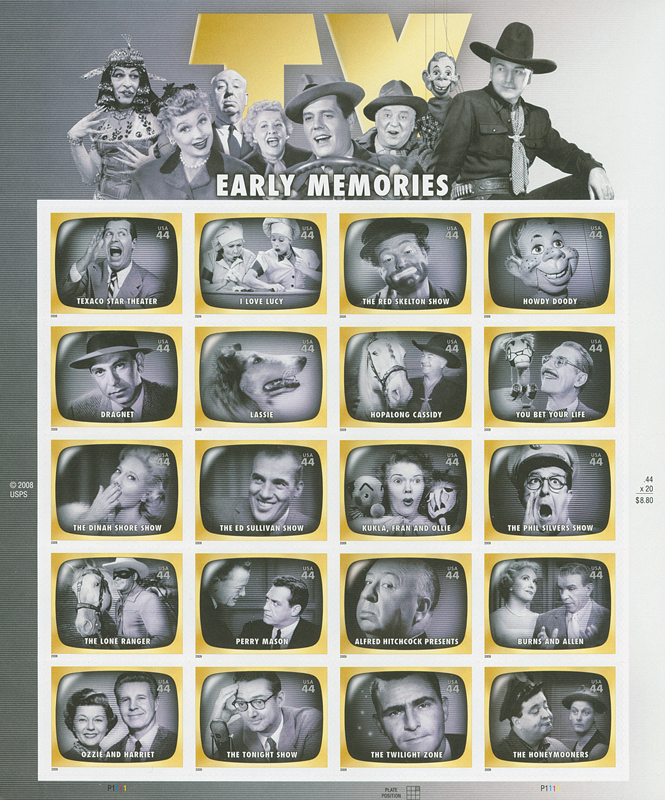
Sullivan is often called a star-maker because many of the guests on his show became household names after their appearances. One of the most famed performances was that of Elvis Presley. In early 1956, Sullivan swore he’d never allow Presley on his show. However, after learning that Elvis’ performance on the Steve Allen Show drew higher audience ratings than his own, Sullivan had a change of heart. Presley was paid $50,000 for three shows, more than any entertainer had ever been paid to perform on a network variety show.
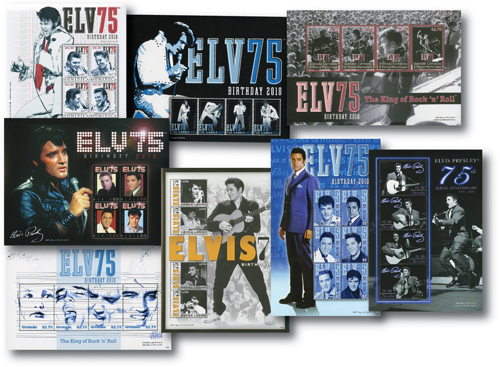
Sullivan then wanted to be the first to debut the next big sensation, and he found it – The Beatles. They made their debut in February 1964 and it was the most-watched TV program in history up to that time.
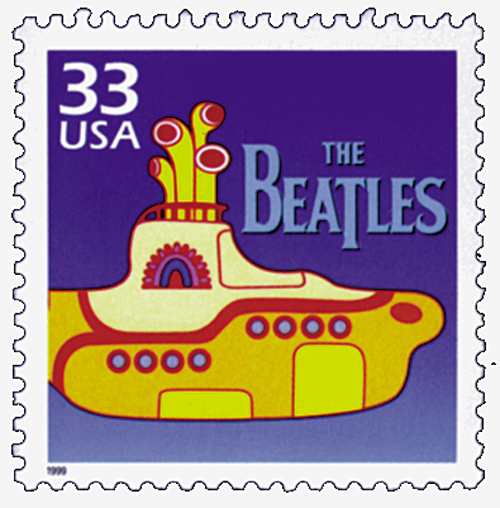
Soon Sullivan became a star himself, with comedians earning laughs for their impressions of him. He also inspired a song in Bye Bye Birdie and appeared as himself in the film adaptation.
In all, The Ed Sullivan Show ran for 24 seasons, totaling 1,068 episodes. Among the most notable performances were the Jackson Five, The Rolling Stones, James Brown, Stevie Wonder, The Doors, and Ray Charles. You can read about other notable performances here. The Ed Sullivan Show has been called “the last great TV show,” and “one of our fondest, dearest pop culture memories.”
Early Television Memories
Issue Date: August 11, 2009
City: North Hollywood, CA
Texaco Star Theater: By 1948, television was just starting to take off. But it needed a face, a superstar, and it found one on radio. Texaco Star Theater transferred its successful radio show to television, and brought along “Uncle Miltie.” The show was a smash hit, with as many as four out of every five television sets tuned in. This variety show had a little bit of everything, including smiling representatives of the sponsor singing the theme song and performing good deeds throughout the show.
I Love Lucy: In the 1950s, a red-headed fashion model found fame as a frazzled housewife, and the whole world fell in love with Lucy. She played a housewife frustrated with her limited lifestyle, compared to her show-biz husband. Their misadventures were a smash hit – it was the top-rated show in the early 1950s, with the highest-rated episode being her trip to the hospital to give birth. The couple’s zany television personalities were the opposite of their savvy, real-life business instincts. As a result, this beloved classic still prospers in syndication more than a half century later.
The Red Skelton Show: Whether portraying an optimistic hobo or a country bumpkin, Red made audiences laugh for 20 years. The hats were the key – by putting on a different hat, he turned into characters that were funny, yet unaware of their own silliness. Nicknamed “America’s Clown Prince,” Red was a master of pantomime who was also famous for his comic clumsiness. For all his laughs, Red always ended his shows on a sincere note and bid the audience farewell by saying “Good night, and may God bless.”
Howdy Doody: Forty-eight freckles peppered the face of the puppet – one for each U.S. state at the time. Red-haired and plucky, he was the all-American boy with the ear-to-ear grin. He and the other puppets were treated as if they were real people, and that helped the young audience look at them the same way. Skits featured humans and puppets working together to solve problems. The show ended on its most famous note, when the clown who never spoke whispered a tearful farewell to the children viewers.
Dragnet: The idea seemed simple – that the daily drama faced by real police officers was as exciting as any that Hollywood scriptwriters could make up. But it had never been done before. The creators of the show worked hard for realism and the actors trained with Los Angeles police detectives. Episodes were based on actual police cases. The steps were the same as those taken by the police in solving the cases, and only the names of the people involved were changed. The result was a gripping drama in the early days of television that set the standard for future police shows.
Lassie: A dog is often called man’s best friend, and that was the case in this long-running series. From 1954-74, the show focused on the relationship of an intelligent collie and her human friends. Loyal and protective, this canine companion constantly helped the humans out of trouble. Little Timmy found himself in a never-ending series of predicaments. Episodes often ended with a cliffhanger, leaving viewers wondering how this canine lady would save the day. The collie became a symbol of faithfulness and perseverence. Ironically, this “female” was played by a male dog.
Hopalong Cassidy: In early television, heroes wore white and bad guys wore black – a simple, but effective imagery. Not so for Hopalong Cassidy. In the rough-and-tumble West, black-clad Cassidy was a model of virtue. He didn’t drink, smoke, or swear. He was always polite to the ladies, and used proper grammar. He had gleaming white hair even as a young man, and wore a black hat. “Hoppy” and his companions protected folks from cattle rustlers and outlaw gangs, providing a standard of decency in the untamed West that was also a model for his young, modern viewers.
You Bet Your Life: No matter how innocent the comment, one waggle of this game show host’s bushy brows could turn it into a blushing confession. Often the interaction between host and contestants was more interesting than the game itself. Each week a pair of contestants, usually including one celebrity, answered contest questions for cash prizes and matched wits with their host. The larger-than-life comic entertained early audiences for 11 years and helped set the standard for future game shows.
Dinah Shore: From 1951-63, Dinah hosted a live musical show with style and grace. She was as warm and easy as her singing voice and was famous for ending each show by blowing an enthusiastic kiss to the audience with an exaggerated “M-wah!” The biggest names in entertainment came to perform on this well-produced show. Using advanced production technology, groundbreaking effects such as flying performers wowed ‘50s audiences. With this showcase of talent, quality, and charm, Dinah found a place in America’s heart.
Ed Sullivan: As television sales began to skyrocket in 1948, America discovered a host of talented performers. Ed was the man to introduce them. A keen evaluator of talent, he had a knack for assessing and satisfying the nation’s interests. Performances by the Beatles and Elvis became legendary, and an appearance on the show was seen as a ticket to stardom. Overall, more than 10,000 entertainers appeared during the show’s 23-year run.
Kukla, Fran and Ollie: A simple set was the forum for an imaginative show. It was just a woman standing in front of a stage, talking with a group of puppets. But the show mixed gentle humor with keen wit, resulting in a children’s show as popular with adults as it was with children. As author James Thurber noted, from 1948-57, the show was “helping to save the sanity of the nation and to improve, if not even to invent, the quality of television.” Whether it was a puppet witch getting arrested by Interpol for flying too low over the United Nations building, or a dragon giving his niece a bath, the puppets appealed to audiences of all ages.
Phil Silvers: It’s hard to be a con man with a heart of gold. That was one theme of this early military comedy. Stationed on a Midwest army base with not enough to do, one Master Sergeant was the resident con artist who constantly cooked up get-rich-quick schemes or plans for promotion. But his main enemy was his own conscience, and often he ended up saving his friends from his own cons. The show lasted from 1955-1959 before being canceled while still popular, and its light-hearted view of the military inspired a host of similar shows.
The Lone Ranger: He was everything a hero ought to be – honest, brave, and righteous. He became a children’s role model – the noble lawman fighting crime and injustice in the Wild West. He was an ex-Texas Ranger whose brother and friends were slain by desperadoes. Armed with expensive silver bullets as a reminder that life (like silver) was precious, the hero and his partner preferred non-lethal means to defeat the bad guys. The duo would then ride away, leaving people wondering, “Who was that masked man?”
Perry Mason: Dramatic courtroom confessions were standard fare for the longest-running lawyer show on television. Debuting in 1957, the show was as much about detective work as it was about the law. The defense attorney was assisted by his junior partner and legal assistant to help his clients. Armed with a keen mind and cool, penetrating stare, this courtroom avenger always found out the truth. Last-minute evidence and exciting courtroom climaxes often led to the wrongly accused being spared and the guilty brought to justice. The show set the standard for other classic criminal dramas. It lasted for nine years and is still popular in syndication.
Alfred Hitchcock Presents: The “Master of Suspense” brought terror into American homes – and audiences loved it. For a director known for his horror films, Alfred also enjoyed sharing his playfully morbid sense of humor with an audience uncertain if it should laugh. Audiences accustomed to light-hearted variety shows and middle-class dramas were introduced to taut thrillers that featured some of the best-known actors of the day. Frequently, the villains appeared to succeed in their mischief. But Alfred always came back to explain how the villains had actually received the justice they deserved.
The George Burns and Gracie Allen Show: It took a lot of intelligence to appear so clueless, and Gracie did it well. George played the “straight man” and was the perfect complement to his scatter-brained wife. A married couple both on screen and off, these vaudeville veterans were the stars of the first show about show business families. George was famous for suddenly stepping outside of the story and chatting with the audience, while fans loved Gracie’s zany antics. She had a gift for making simple tasks seem complicated. The show ended when she retired in 1958, saying “good night” for the last time.
Ozzie and Harriet: The show was about a family of entertainers played by the real-life family members. This included the father, the mother, and their two sons. The youngest son played music on the show to impress a girlfriend, and it was very popular. He went on to have a successful pop music career. America watched the boys grow during the course of the series, and when they got married in real life, their wives joined the show. The focus on daily events created an image of the ideal American family.
The Tonight Show: A little entertainment, light chat, a skit or two – that was the idea behind this show that premiered in 1954. Starting out as a local New York City broadcast, it quickly went nationwide and has been going strong for more than half a century. It was light musical comedy to start – when Steve stepped over to the piano, the audience was treated to some light banter or musical improvisation. Later hosts influenced the show with their unique personalities. But some things have lasted through the years, such as the opening monologues and decades of entertaining audiences.
Twilight Zone: Early television did not allow social commentary on contemporary issues such as nuclear war or bigotry, but this unique show found a way around censors. These hot-button topics were explored by presenting the stories as science fiction, featuring things like space aliens, time travel, or alternate worlds. The narrator opened every episode with sly irony, inviting early audiences into a world where anything was possible, yet people were still bound by their nature.
The Honeymooners: The working class found its champion in this show about the ultimate underdog. Starring Ralph, a blustering bus driver, and his sensible wife, Alice, this classic dominated early television. Living in a small, mostly empty apartment, Ralph had dreams much bigger than his salary could grant him. With his upstairs neighbor Ed as his sidekick, Ralph cooked up schemes to make the big score, but things never worked out as he hoped. Audiences related to the day-to-day struggles of this working-class couple.
Birth Of Ed Sullivan

Legendary TV personality Ed Sullivan was born on September 28, 1901, in Harlem, New York City, New York.
Sullivan grew up in a musical household, with someone always singing or playing the piano. Sullivan was a gifted athlete, playing football, basketball, baseball, and track.
While in high school, Sullivan wrote sports news for The Port Chester Daily and was hired full-time after graduation. Over the next decade, he continued to work as a sports writer and editor for a series of different newspapers. Then in 1929, he was made the Broadway columnist for The Daily Mirror. During this time he would also do show business broadcasts on the radio. And in 1933, he wrote and starred in the film, Mr. Broadway.

Sullivan soon earned a reputation as a star-maker, while continuing to write, produce vaudeville shows, and organizing benefit concerts. He was also made the host of the Summer Silver Theater variety program in 1941.
In June 1948, Sullivan was hired to host a weekly Sunday night variety TV show called Toast of the Town (it would later be renamed The Ed Sullivan Show in 1967). Initially, Sullivan and his show received poor reviews, with some complaining he had no personality and was awkward. But Sullivan soon won over viewers as the “average guy” bringing them entertainment in their homes. Sullivan had an instinct about what people liked and managed to create an interesting balance for the show. An episode would usually include a vaudeville act, a comedian, a singer, a jukebox star, a theatre performer, an athlete, and a visit with Topo Gigio, the Italian mouse puppet.

Sullivan is often called a star-maker because many of the guests on his show became household names after their appearances. One of the most famed performances was that of Elvis Presley. In early 1956, Sullivan swore he’d never allow Presley on his show. However, after learning that Elvis’ performance on the Steve Allen Show drew higher audience ratings than his own, Sullivan had a change of heart. Presley was paid $50,000 for three shows, more than any entertainer had ever been paid to perform on a network variety show.

Sullivan then wanted to be the first to debut the next big sensation, and he found it – The Beatles. They made their debut in February 1964 and it was the most-watched TV program in history up to that time.

Soon Sullivan became a star himself, with comedians earning laughs for their impressions of him. He also inspired a song in Bye Bye Birdie and appeared as himself in the film adaptation.
In all, The Ed Sullivan Show ran for 24 seasons, totaling 1,068 episodes. Among the most notable performances were the Jackson Five, The Rolling Stones, James Brown, Stevie Wonder, The Doors, and Ray Charles. You can read about other notable performances here. The Ed Sullivan Show has been called “the last great TV show,” and “one of our fondest, dearest pop culture memories.”

